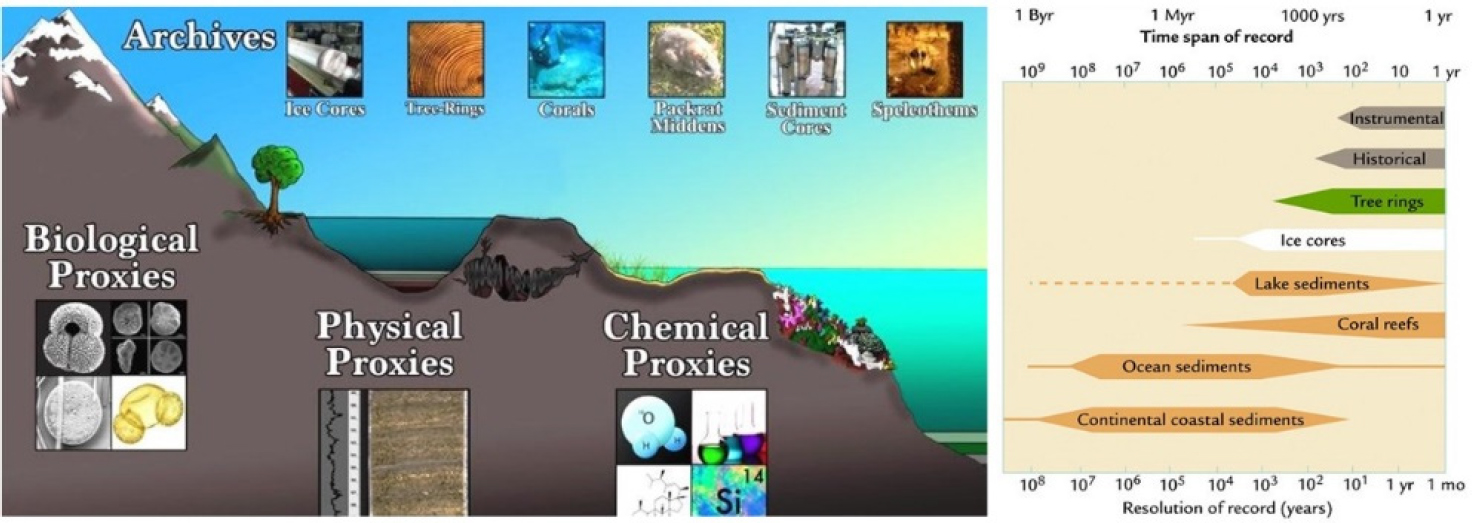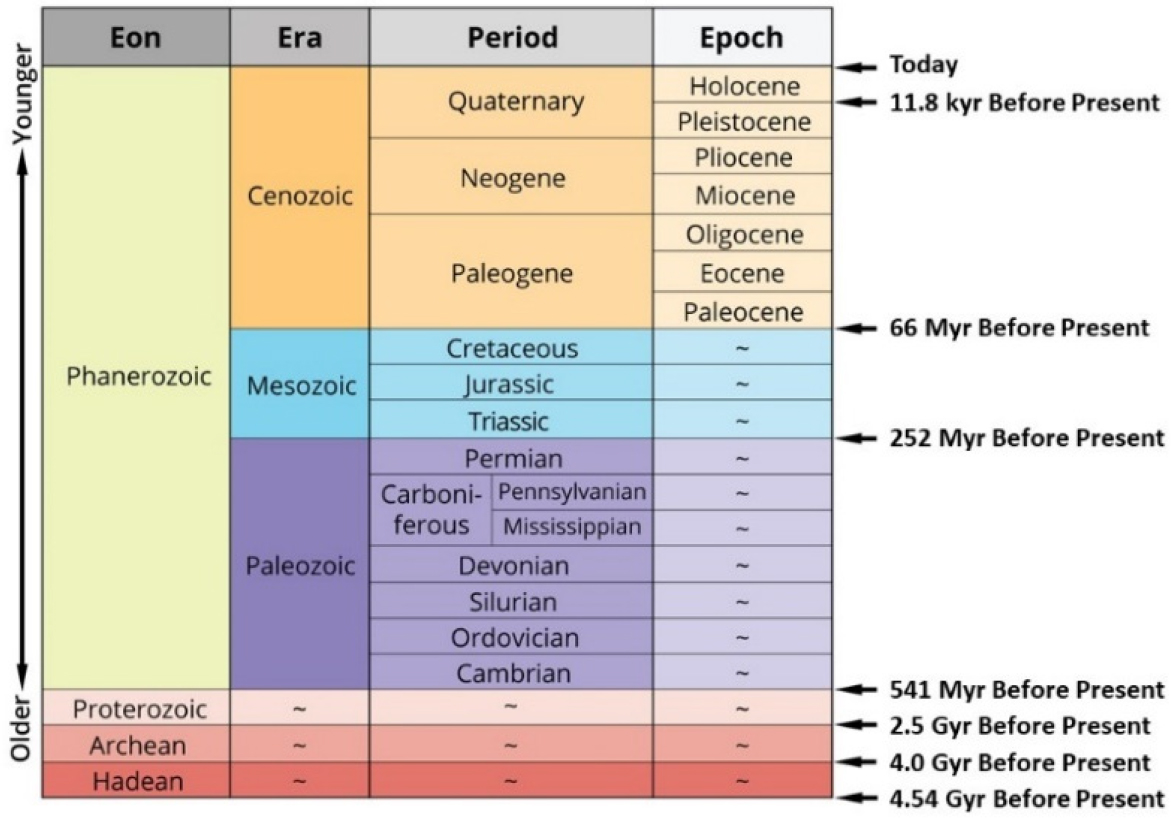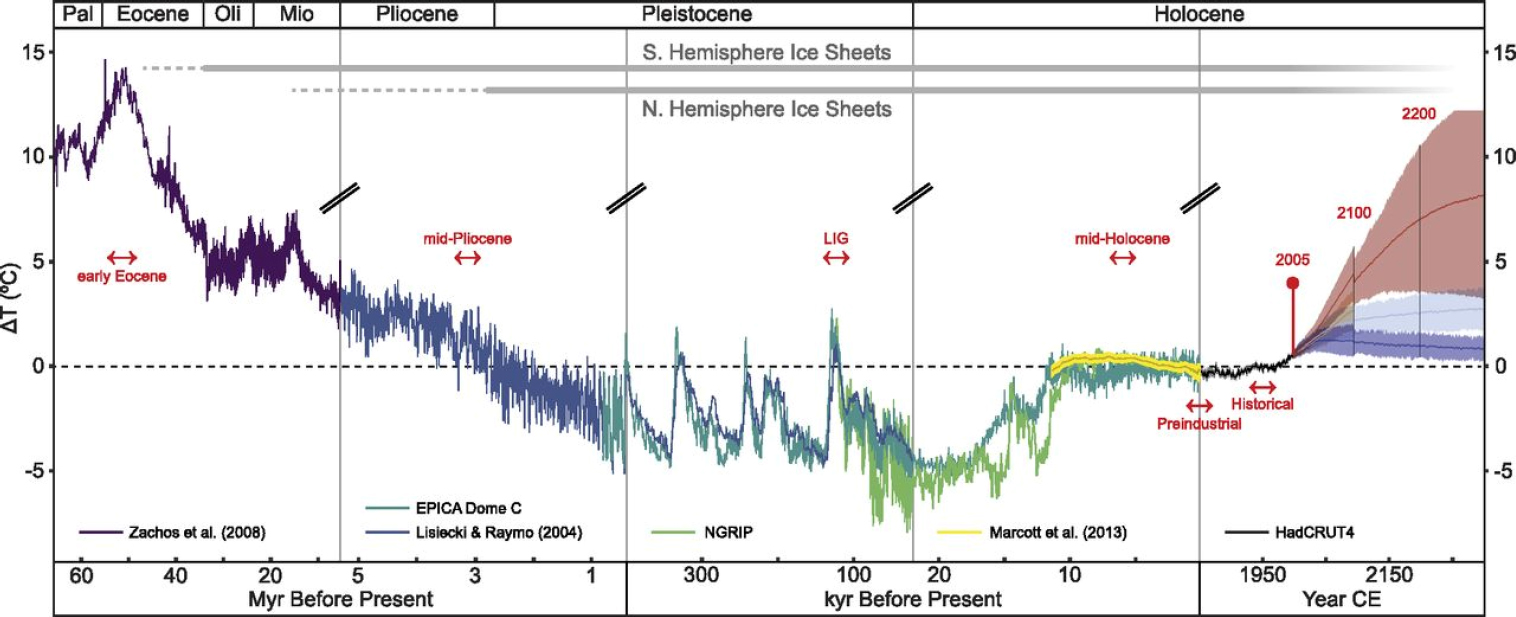Introduction
Paleoclimatology is a broad and highly integrative field that aims to understand the variability of Earth's past climate system. Throughout its 4.54-billion-year history, Earth’s climate system has undergone dynamic changes that have transformed the surface of the planet and the evolution of its biodiversity. Key components of the climate system, such as the atmosphere, ocean, solid earth, ice, and vegetation, interact in complex ways in response to both internal and external factors (forcings), leading to measurable responses. Changes in the strength of the sun, Earth’s orbital configuration, plate tectonics, volcanic eruptions, greenhouse gas concentrations, and human activities are examples of such forcings, which may manifest as responses that are regionally variable. Responses of the climate system to forcings may be amplified or dampened by feedbacks—interactions between climate system components that can alter climate changes already under way.
The complicated history of Earth’s climate is recorded in a global distribution of geological, cryological, and biological archives, including marine- and land-based sediments, ice, corals, cave deposits, trees, and other records, which precede and often overlap the historical and instrumental records of the last 100–200 years (Figure 1). These archives provide quantitative and/or qualitative information about past climates and climate system interactions that is inferred from evidence rather than measured directly. Ice cores, for example, which can be collected by drilling through dense ice sheets or glaciers, contain dust and small air bubbles within layers of snowfall that preserve greenhouse gases and other atmospheric components present at a given time. The ice can then be evaluated with radiometric dating to identify when atmospheric components changed. This is one of many examples of paleoclimate records that have been studied to explore such topics as the interplay between global temperatures, ice growth, and greenhouse gas concentrations over the past 2 million years. Other quantitative records include tree-ring thickness, counts of plankton or pollen in sediment layers, coral growth bands, and speleothem growth, physical and chemical properties of which can vary in predictable ways due to changes in climate (also shown in Figure 1). Such properties, or indirect indicators of past climates preserved in climate archives, are referred to as proxies.
Paleoclimate records present unique challenges with regard to data collection, preservation, and proxy interpretation. Establishing dates for paleoclimate proxies can be challenging and relies on the careful geochemical assessments and calibration of radiometric dating techniques, as well as

comparisons with other records. Taken together, however, proxy records paint a detailed picture of climate changes that have unfolded in the past (e.g., alternating ice ages and warm interglacial periods, periods when earth temperatures were substantially warmer and cooler than the present).
Climate changes span several timescales. Faster changes at shorter timescales are embedded in and superimposed on slower changes on longer timescales. For example, paleoclimate researchers have compiled records showing a slow warming of Earth’s climate between 300 and 100 million years ago, followed by cooling for much of the Cenozoic Era, 66 million years to present, (Figure 2). That cooling led to the development of massive polar ice sheets that have advanced and retreated during the last 3 million years on cycles of several tens of thousands of years during the Quaternary Period, including the Pleistocene and Holocene Epochs (Figure 3). Superimposed on these changes are shorter fluctuations between warm and cool climates on millennial timescales. Over the last 1,000 years, proxy records demonstrate that the climate has been relatively warm and stable, with smaller fluctuations. Older records, particularly those for deep time (greater than 200 million years ago) tend to have lower resolution, as more limited data is preserved.
Studying the impacts of climate variability2 in the past can inform how projected air and ocean temperatures will affect the Earth system in the future, including ocean circulation; sea level; marine and terrestrial ecosystem health; and the occurrence and intensity of flooding, drought, storms, wildfires, and
___________________
2 Climate variability is defined as deviations of climate variables from a given mean state at all spatial and temporal scales beyond that of individual weather events (IPCC, 2021).

other phenomena. While paleoclimate changes are not a perfect analog for those of the present, they provide valuable insight into how components of the Earth system respond to greenhouse gas levels and other forcings, as well as provide context for present-day measurements.
Rapid changes unfolding in the present-day climate highlight the importance of understanding past climates. The 2021 Intergovernmental Panel on Climate Change (IPCC) Assessment Report 6 (AR6)3 integrates data from paleoclimate archives across its chapters to synthesize present observations with what is known about the past, and what needs to be known about processes that will drive future changes in response to natural and anthropogenic forcings (IPCC, 2021). Paleoclimate data has provided key constraints on models used to project future changes, such as sea-level rise and ice-sheet variability (e.g., DeConto and Pollard, 2016) and has been used in climate model development. Over the past decade, paleoceanography and paleoclimate research has advanced understanding of the magnitudes, rates, and drivers of past climate variability on a range of timescales, providing a baseline and understanding for use in assessing current and future climate
___________________
3 This workshop occurred prior to the publication of the IPCC AR6 Working Group 1 report in August 2021.

sensitivity and climate change. These advances reflect progress in developing and understanding new proxies, as well as in integrating these proxy records with numerical models.
In June 2021, the Board on Atmospheric Sciences and Climate together with the Polar Research Board, the Ocean Studies Board, and the Board on Earth Sciences and Resources of the National Academies of Sciences, Engineering, and Medicine convened a workshop to identify potential future paleoclimate research directions that will help advance understanding of current and future change in the Earth’s climate system. See Appendix A for the statement of task to the workshop planning committee; see Appendix B for biographical sketches of the planning committee members; and see Appendix C for the workshop agenda.
This proceedings summarizes workshop presentations and discussions in the breakout and plenary sessions. This proceedings has been prepared by the workshop rapporteurs as a factual summary of what occurred at the workshop. The planning committee’s role was limited to planning and convening the workshop.
BACKGROUND AND MOTIVATION FOR THE WORKSHOP
Soumaya Belmecheri, National Science Foundation (NSF), provided context and background on NSF’s Paleo Perspectives on Climate Change (P2C2) program and shared NSF’s motivations for sponsoring the workshop. P2C2 is an annual competition across the NSF Geosciences directorate; it involves core programs from the Divisions of Atmospheric and Geospace Sciences, Earth Sciences, Ocean Sciences, and the Office of Polar Programs. P2C2 was an outgrowth of the Earth System History (ESH) Program of the U.S. Global Change Research Program, a product of the Global Change Research Act of 1990. In 2006, Belmecheri explained, ESH was re-evaluated through a partnership
between the American Geophysical Union and NSF, some of which informed the themes of the P2C2 solicitation that originated in 2008. The research areas currently supported by P2C2 are described in Box 1.
The P2C2 program has facilitated data synthesis, proxy development, and data-model comparison, as well as multiple large-scale international collaborative projects. Over the past decade, paleoclimate research has advanced the understanding of the magnitude, rate, and drivers of past climate variability on a range of timescales; however, Belmecheri explained, NSF recognizes that the science has evolved and reviewing the P2C2 program is necessary and timely. Together with the community questionnaire (Box 2), the workshop represented outreach on behalf of NSF to the scientific community and an opportunity for the paleoclimate research community to share an individual and joint vision for the paleoclimate research future.
In her opening remarks, the planning committee Chair, Andrea Dutton, University of Wisconsin–Madison, shared her perspective that among the geosciences community, there is a general understanding that climate-related research should be a top priority. The paleoclimate community can contribute to tackling the challenge of climate change. The workshop was an opportunity for the community to develop a vision for the future of paleoclimate research. Dutton challenged the community to think about emerging scientific themes and how the P2C2 program could help the community achieve those scientific goals.
WORKSHOP PLANNING AND STRUCTURE
Planning of the workshop topics and themes was informed by the online community questionnaire (Box 2) conducted to solicit broad feedback from the community, and the workshop was designed to address the activity’s statement of task (see Appendix A). The workshop was structured around three wide-ranging themes intended to be as encompassing of the paleoclimate community as possible: understanding past climate forcings and sensitivity; glacial, ocean, and land processes and feedbacks; and resolving regional climate change. In order to maximize the number of voices and provide opportunities for extensive feedback, the workshop agenda included a series of panel and breakout discussions. For the panels organized around topical themes, speakers’ remarks responded to the statement of task from the point of view of their expertise. Breakout discussions built on the panel discussions: participants self-selected their topical rooms, and the moderators guided participants through a series of questions. Participants provided anonymous
input via Google Jamboard, and moderators summarized key takeaways from the breakout discussions during the plenary.
An asynchronous session dedicated to issues of belonging, accessibility, justice, equity, diversity, and inclusion (BAJEDI) was held across the 3 days of the workshop: participants responded to question prompts, and their responses were presented at the end of the workshop. At the end of the first day of the workshop, there was a breakout discussion for late-stage Ph.D. students and postdocs, and feedback was gathered throughout the workshop and presented at the end of the workshop.
Proceedings Roadmap
The organization of this proceedings largely follows the structure of the workshop sessions, during which all of the participants responded to the questions posed in the statement of task: What are the gaps in our current understanding? What research strategies and tools can be used to fill these
gaps? How can paleoclimate science be relevant to the nexus of science and decision making? Chapters are organized around topics and themes that emerged from each session, integrating panelists’ remarks with key takeaways from breakout discussions. The penultimate chapter summarizes the asynchronous BAJEDI session, and the final chapter provides a high-level summary of key takeaways. Cross-cutting themes are highlighted as boxes throughout each section, giving examples of their relevance to research needs.








